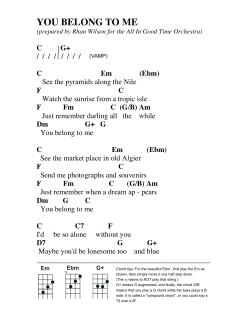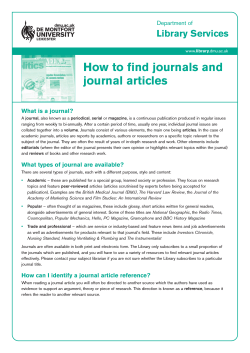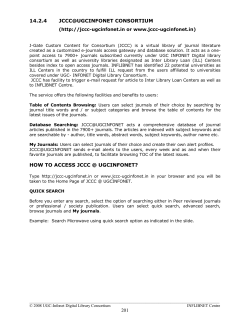
HOW TO SEARCH A DATABASE ACADEMIC LIBRARY GATEWAY
HOW TO SEARCH A DATABASE ACADEMIC LIBRARY GATEWAY Basic vs. advanced search http://www.fmed.uniba.sk/?library - Basic search runs a search based on a word or phrase entered into a search box. This usually searches across all the fields of the database records. Comenius University in Bratislava Faculty of Medicine Academic Library - Advanced search runs a complex search query based on multiple search criteria entered into selected search fields. This will refine the search. Searching with Boolean operators - Using "and" will find all entered words. They may appear in different parts of the document and in any order (hypertension and therapy). This will narrow the search. - Using "or" will find either or both terms (therapy or treatment). This will broaden the search. - Using "not" will exclude a second concept (AIDS not HIV); it will exclude documents containing the word „HIV" and makes the search more focused. Use it with caution. Searching vs. browsing Browsing is the process of searching in alphabetical indexes such as: author, title, subject heading, etc. Searching is the process of entering a search query with the use of logical operators. CITING REFERENCES The Citing is based on the International Standard ISO 690:2010(E). 3rd ed. Information and documentation — Guidelines for bibliographic references and citations to information resources. The Slovak version was issued in 2012. A brief citing guide according to ISO 690:2010 See at: http://www.fmed.uniba.sk/index.php?id=library – SLOVAK What is plagiarizing? Plagiarism interactive tutorial: http://www.lib.usm.edu/legacy/plag/plagiarismtutorial.php A guide to ethical writing: http://ori.hhs.gov/sites/default/files/plagiarism.pdf Citation management tools is a bibliography and reference management software associated with the citation database Web of Science. It allows to store, manage, import and edit the format of the references according to the journals. Software is also accessible outside the University via remote access at: www.myendnoteweb.com. Bibliobox – a facility for returning books outside the opening hours of the library. It is located in front of the entrance to the library. SELF-STUDY RESOURCES Ways to find medical information on the Internet http://www.fmed.uniba.sk/index.php?id=library Úvod do vedeckej práce pre študentov medicíny a doktorandov medicínskych odborov – SLOVAK http://www.fmed.uniba.sk/index.php?id=e-knihy The portal MEFANET is the platform of Slovak and Czech medical faculties to publish electronic educational materials. http://portal.fmed.uniba.sk/index.php Academic Library Faculty of Medicine Comenius University (AL FM CU) Odborárske nám. 14 813 72 Bratislava 1 Phone number: 02 - 59359 437 THESES (inspiration when choosing a topic or when searching for a document in a list of references) - http://www.crzp.sk/ Other resources available on the Internet Safari (accessing, finding and reviewing information) http://www.open.ac.uk/safari/index.php Developing a search strategy http://monash.edu/library/skills/resources/tutorials/searching/ EBM/EBD Tutorials http://medlib.bu.edu/tutorials/ebm/ Instructional materials to assist you with writing: The Writer’s Handbook - http://writing.wisc.edu/Handbook/ Online Writing Lab - http://owl.english.purdue.edu/owl/ For further information, contact or visit our library. http://www.fmed.uniba.sk/?library kniznica.info@fmed.uniba.sk kniznica.pozicovna@fmed.uniba.sk SOURCES OF INFORMATION IN THE FIELD OF MEDICINE WHERE TO FIND SCHOLARLY LITERATURE Types of information sources Bibliographic electronic resources available through the Gateway of the AL A primary source in medicine is a document that offers facts about the research written by authors directly participating in the research. Example: journal articles, theses, clinical trials, research notes, case reports, conference papers. A secondary source summarizes primary sources usually to provide an overview of the current understanding of a medical topic, to make recommendations, or to combine the results of several studies. Example: literature reviews or systematic reviews, books, data compilations, meta-analyses, guidelines. A tertiary source usually summarizes primary and secondary sources. Example: encyclopedias and other compendia. Types of journals Peer-reviewed journal (refereed journal) - articles written by researchers and reviewed by experts in the particular field before the article is published in order to insure its quality. It is a trusted information source based on original research. For the list of Slovak and Czech peer-reviewed medical journals visit the links at the bottom of the AL gateway and open these files: A bibliographic database – a database of bibliographic records, an organized digital collection of references to published literature (it may include an abstract, the keywords or other information). It may also offer a link to the full-text accessible in external databases. Bibliographia Medica Slovaca (BMS) – SLOVAK - freely available database of Medicine and Health sciences contains records of the articles published in the professional Slovak journals and records of the Slovak authors published in Czech journals. The articles are in Slovak, Czech, and fewer in English. Bibliographia Medica Čechoslovaca (BMČ) – CZECH - the Czech National Registering Bibliography in biomedicine collects records about all professional literature published in the Czech Republic from 1947 (The Slovak literature is included until 2000). The articles are in Czech, Slovak, and fewer in English or other languages. RECENZOVANÉ BIOMEDICÍNSKE ČASOPISY – SR / ČR Indexed journals are registrated by leading academic and commercial publishers like ISI Web of Science, PubMed, SCOPUS, Excerpta Medica/EMBASE, etc. Current journal - scientific journal registered by ISI Current Contents and is searchable in one of a series of thematic databases Current Contents Connect ® (CCC), available via Web of Knowledge. Other types of journals: Trade journals include industry related articles; popular magazines do not include scientific information. These kinds of journals are usually not suitable for scientific research. Where to search for scholarly articles in English? PubMed is the most comprehensive bibliographic database created by National Center for Biology Information (NCBI) covering the fields of medicine, nursing, dentistry, veterinary medicine, the health care system, and the preclinical science. It is freely available. It indexes articles (75% with abstracts) from biomedical journals with links providing access to the full-text journal articles when available. Medical Subject Headings (MeSH) – a thesaurus of controlled vocabulary used for indexing documents in PubMed. You can also build a search using MeSH terms. Types of articles Evidence Based Medicine (EBM) Research article reports the methods and results of an original study performed by the authors. Evidence-based medicine is a systematic approach to clinical problem solving which allows the integration of the best available research evidence with clinical expertise and patient values. EBM databases contain results of independent high-quality clinical research. Review article summarizes the information available on a specific topic, analyzes or discusses research previously published by others Case report is a detailed report of the symptoms, signs, diagnosis, treatment, and follow-up of an individual patient. Letters to the editor provide a way for readers to express comments, questions, or criticisms about articles published in that journal. Types of EBM documents: meta-analyses, systematic review, randomized controlled trial, cohort or case-control. EBM databases: BMJ Clinical Evidence, DynaMed, UpToDate, Best Practice, EBM search Interface in PubMed, etc. – electronic register (at the AL website) containing the alphabetical list of journals available in print form. FULL-TEXT ELECTRONIC RESOURCES ACCESSIBLE THROUGH THE GATEWAY OF AL Licensed full-text databases and e-journals Freely accessible full-text e-journals Licensed full-texts e-books E-journal portal: Scientia.sk A portal allows simultaneous search in various electronic information resources with the fulltexts linking feature. E-Learning presentations – SLOVAK Topics: Scientometria, Informácie na internete, Súborné online katalógy, Databázy, Elektronické informačné zdroje, EBM, Princípy citovania, Open Access. Multidisciplinary citation databases contain bibliographic information about documents, are used as a tool for ranking and mapping scientific knowledge and for following and evaluating citation rates of journals, researchers and institutes. These databases provide quantitative tools for ranking, evaluating, and comparing journals (Impact Factor), authors (H-index), etc. Journal Citation Reports® (JCR), available on the platform of Web of Knowledge (WOK), offers quantitative metrics like the Impact Factor, median Impact Factor, Eigenfactor Score®, etc. is a bibliographic and citation database including mainly journals from the European region. The database offers the indicator SCImago Journal Rank (SJR) to measure scientific influence of scholarly journals, H-index to measure the productivity and quality of the authors. Information about the Remote access to the electronic resources is available at the library website http://www.fmed.uniba.sk/index.php?id=access
© Copyright 2025














